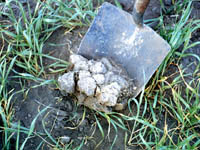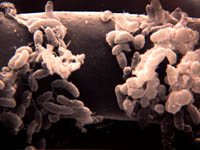|
|

|
| Modern farming operations are largely designed for one thing - maximize profit. Farm
management addresses all factors in the farm business such as capital,
labour, crops, livestock and land. Farm management juggles these factors in an attempt to
maximize profit. Land or soil management attempts to adjust soil factors in a way that maximizes
crop production at the lowest cost. A wise management scheme will look to the future so that
the land continues to produce crops economically for many years, while leaving the soil
in a productive state (Sustainable agriculture) generations. Good soil management
attempts to preserve the best physical,
chemical
and biological characteristics.
Specifically, soil management encompasses all human activities concerning the soil. The objectives of soil management are to control soil degradation and to improve soil productivity. Good soil management emphasizes the following:
In short, good soil management attempts to preserve the best physical, chemical and biological conditions. In Saskatchewan, there are three major soil problems that affect large areas of the province: | |||

A soil with good physical condition is important to germinating and growing plants and to minimize soil erosion. When soil is compacted, plant roots have difficulty penetrating the soil, and air and water do not move as readily. The water and air are essential for plant growth, so compaction may lead to plant death. Use of heavy equipment and loss of organic matter are two factors that contribute to this problem. Some soils that have formed on parent material rich in sodium salts have naturally poor structure, particularly in the Bnt horizon (see image). Man's activities such as the placement of oil and gas pipelines, open gravel pits and open pit mining, cause soil disruption. Often the fertile A horizons are buried or scraped away leaving unfertile parent material behind. Natural structure is destroyed and drainage problems can result making reclamation difficult and expensive. Good "tilth" is achieved by adding crop residues back to the soil and by appropriate tillage (or no-till) practices coupled with a good program of fertilization and pest control. Crop rotations that involve deep rooted plants such as alfalfa will help improve the structure of subsoils. | |||

Chemical Conditions The most important soil chemical conditions that must be monitored are: soil nutrient levels, pH (acidity or alkalinity), and salinity. Pollution is a common problem in soils often resulting from over use of fertilizers and pesticides. Contamination can also occur from industrial sources such as mining operations, oil drilling, pipeline bursts and poor toxic waste management. The image shows saline areas on fields that have been irrigated. Often the salt washed out of the profile can move considerable distances before surfacing. | |||

Biological Conditions The biological activity of soils is directly related to the quantity and quality of soil organic matter and physical conditions such as temperature and moisture. The sustainability of soil organic matter levels is crucial to maintaining a healthy soil organism population. Soil organisms need organic matter for food and the soil needs humus for tilth, nutrient supply and water holding capacity. The most important management practice that affects biological activity is the return of crop residues to the soil. Modern techniques of leaving standing stubble after combining and direct seeding directly into the stubble the following spring has many advantages:
|